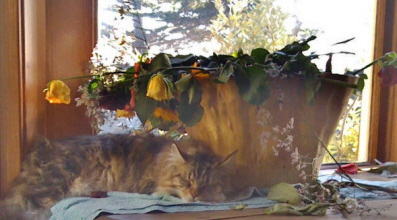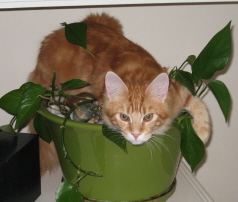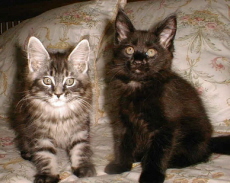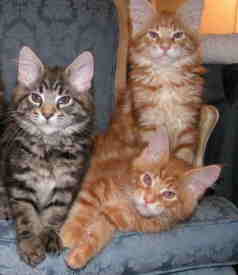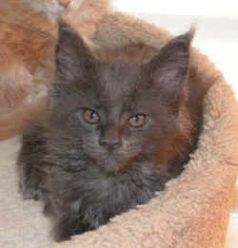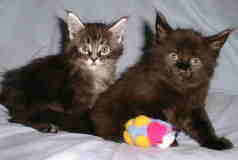
|
|
Plants poisonous to cats |
Well, we used to have houseplants, and some years, if we don't have little kittens, we decorate the house for the holidays in December. But both plants and decorating change when you have cats in your home.
A lot of our plants and holiday decorations live outside now where the cats can't reach them. Even if someone sends us a beautiful bouquet, we place it outside and look at it through the window, (note Windwalker Kiva's demolition job on her owners' bouquet in the picture above).
Below is a list of plants that must be avoided if you have cats. Be especially careful of bouquets of flowers.
While in some cases, just parts of a plant (bark, leaves, seeds, berries, roots, tubers, spouts, green shells) might be poisonous, you can't have any plant that's on this list anywhere that your cat might have access to it. If you must have any of them, keep them safely out of reach.
If your cat eats part of a poisonous plant, rush him or her to your veterinarian as soon as possible. If you can, take the plant with you to help identify it
(No cats were harmed in the incidents depicted in these photographs.)
|
|
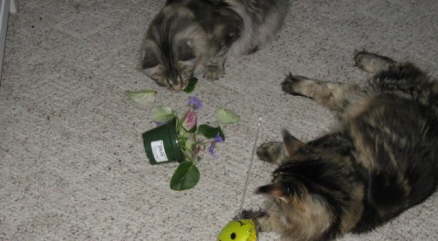
Windwalker Tecumseh ("Moose) and Windwalker Roman Coliseum ("Romi") examine the plant they have just demolished.
|
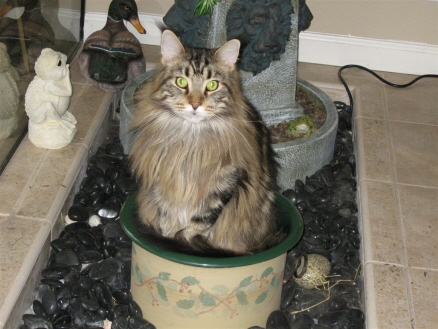 |
|
Holiday dangers |
Helpful hints to keep your cat happy and healthy during the holiday season.
- Don't use tinsel on your tree! Decorate your tree with animal safe ornaments such as dried non-toxic flowers, wood, fabric or pinecones. If ingested, ribbons or tinsel can become lodged in the intestines and cause intestinal obstruction. This is a very common problem with kittens.
Keep aluminum foil and cellophane candy wrappers away from pets. They can cause vomiting and intestinal blockage.
- Be careful with holiday floral arrangements. Lilies are commonly used and many varieties including Tiger, Asian, Japanese Show, Stargazer and Casa Blanca can cause kidney failure in cats. Safe alternatives can include artificial flowers made from silk or plastic.
Common Yuletide plants such as mistletoe and holly berries can be toxic to cats. If your cat eats mistletoe, he or she could suffer gastrointestinal upset and cardiovascular problems. Holly can cause vomiting, nausea, diarrhea and lethargy if ingested.
Poinsettias are considered to be very low in toxicity, however, they could cause mild vomiting or nausea if ingested by your cat.
- Christmas tree water may contain dangerous fertilizers, which if ingested, can cause stomach upset. Stagnant tree water can also act as a breeding ground for bacteria and if ingested your cat could end up with nausea and diarrhea.
Chocolate poisoning does not seem to be a problem in cats, although it could be possible if enough is ingested.
- Boiled or grilled meats can be offered as a healthy alternative, but don't give pets holiday leftovers and use tightly-covered garbage containers. Cooked poultry bones can splinter and cause blockages. Greasy, spicy and fatty for spoiled foods can cause stomach upset and moldy foods could cause tremors or seizures.
Older cats have more delicate digestive systems and nutritional requirements, so it's best to keep them on their normal diet. Any change of diet, even for one meal, may give them severe indigestion and diarrhea.
- Alcohol and pets do NOT mix. Place unattended alcoholic drinks where pets cannot reach them. If your cat drinks it, he or she could become very sick and weak and may go into a coma.
back to top |
| What would you do if you had to evacuate |
We all need a disaster plan. Neighborhood and community groups and city fire departments offer classes so you can develop a plan for your family, and pets are often part of the plan. Whether you must evacuate or shelter in place, you're supposed to plan on having what you'll need for three days, and assume no utilities (including water).
- The "blue bags" from Ikea a great for organizing items that you might need to "grab and go" quickly -- they are about $2 each, very sturdy and hold a large amount (they are "square" at the bottom, so they pack like a box or a bin, but are more flexible than a box so are easier to stuff into a car or van).
The pre-packed bags are on shelves in the garage next to the door, so they are easy to "grab and go". They contain the following items:
- 12 disposable litter pans
-
5 pop-up kennels
- 12 large plastic bowls for water
-
a large package of small paper plates (a hundred or so)
-
a litter scoop
- a dozen small bags of silica litter (available at Walmart). Even if you don't use this litter, it's much lighter than regular or clumping litter, and one small bag will last one cat for a few weeks.
- two bags of dry food. I replenish this supply, so it's always fresh.
- two five gallons jugs of water
Hopefully this list will help you get organized, as it is very, very important to have a plan in place. Our camper van is our emergency escape vehicle, so much of what WE need is already in it.
|
|
DISCLAIMER
The information on this website is NOT intended to replace
the advice of a Veterinarian.
If your cat is displaying symptoms of illness or discomfort,
seek the medical advice of a Veterinarian IMMEDIATELY.
Windwalker Maine Coon Cats accepts no responsibility for the accuracy
and content of the information provided by this website.
|
|
|
|
